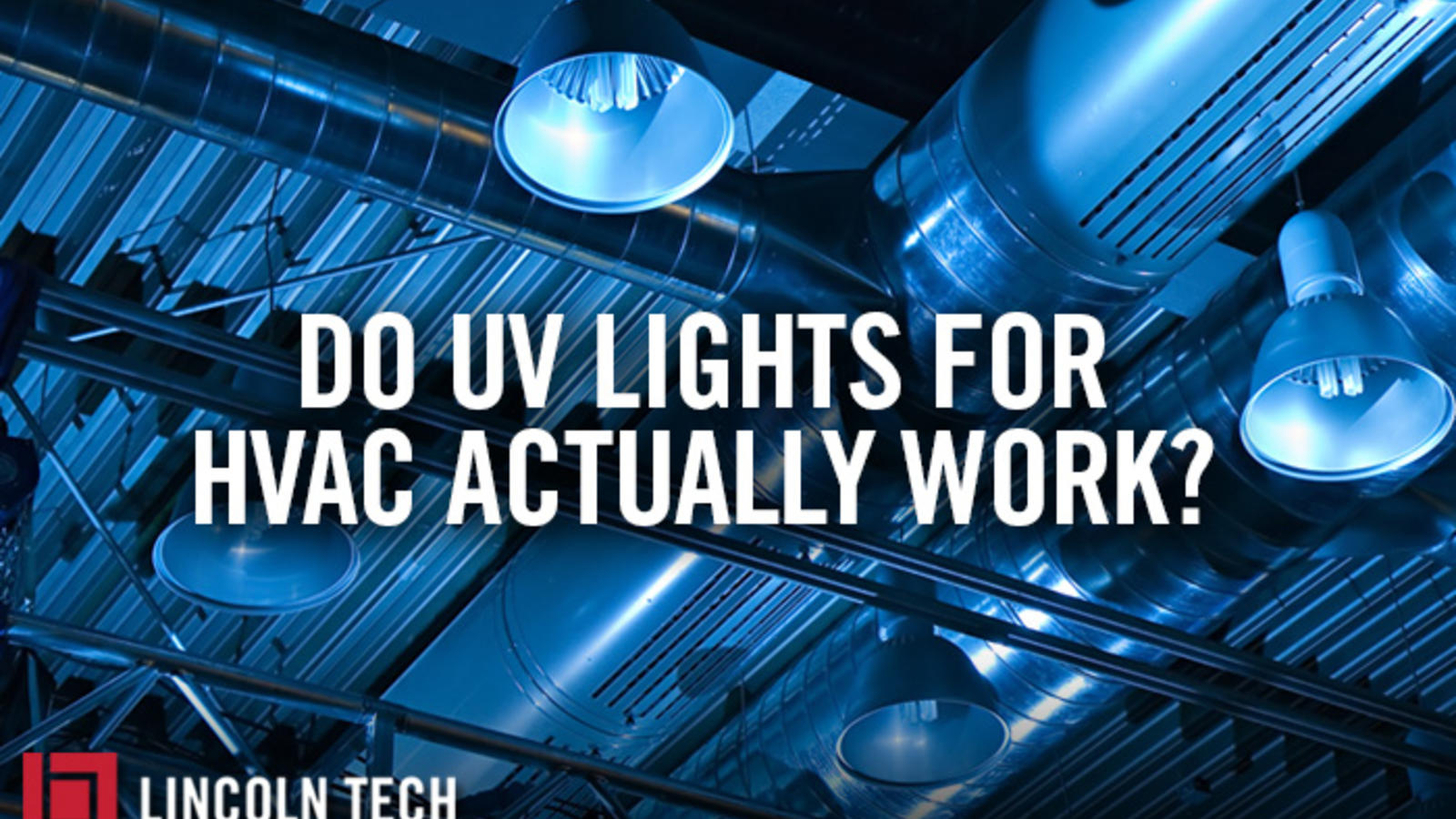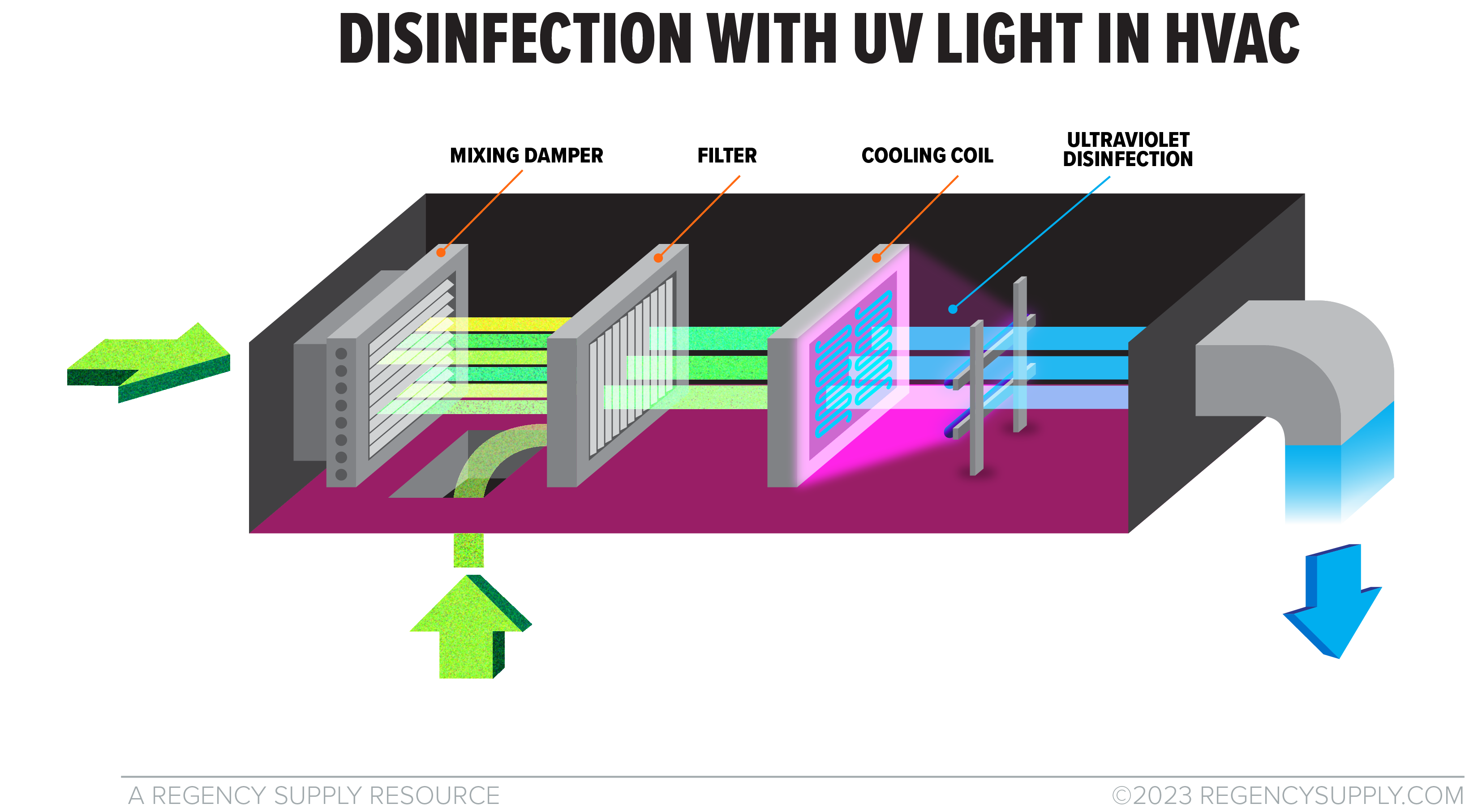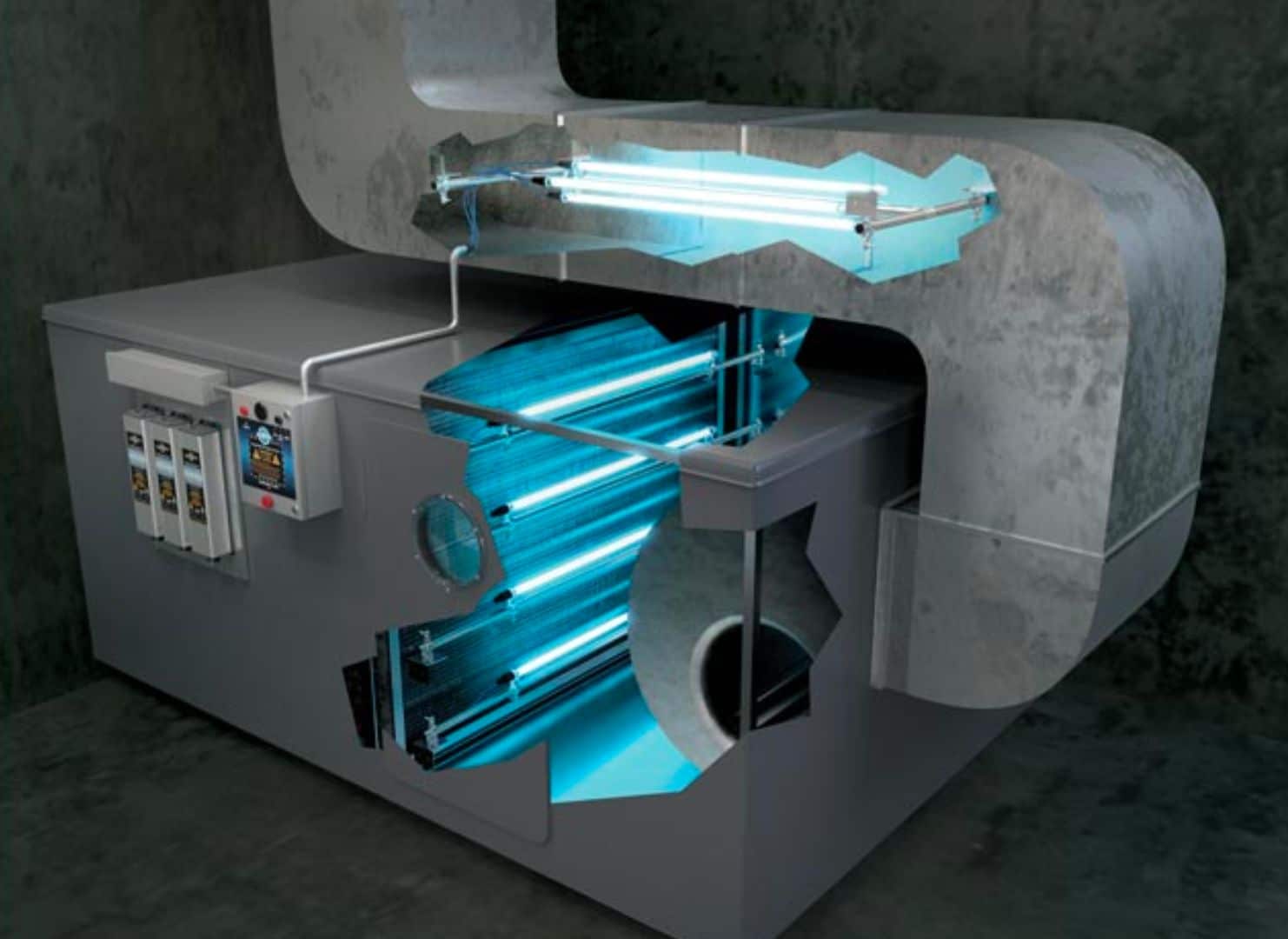Affiliate Disclosure
HVAC Guide Guys is a participant in the Amazon Services LLC Associates Program, an affiliate advertising program designed to provide a means for sites to earn advertising fees by advertising and linking to Amazon.
How Do HVAC UV Lights Work? By emitting UV-C light, these lights disrupt the DNA of microorganisms, preventing them from reproducing. This process helps reduce allergens and improve overall air cleanliness in the home. UV lights are a popular addition to HVAC systems for their ability to enhance air quality and create a healthier living environment for occupants.
HVAC UV lights work by using ultraviolet radiation to kill mold and bacteria in the air. These lights are installed in the HVAC system to improve indoor air quality.

Credit: www.lincolntech.edu
Table of Contents
Introduction To HVAC UV Lights
HVAC UV lights work by using ultraviolet radiation to kill mold, bacteria, and viruses in the air. When the UV light is installed in the HVAC system, it sterilizes the air as it passes through, improving indoor air quality and reducing the risk of airborne illnesses.
The Role Of UV Lights In Air Purification
UV lights play a crucial role in maintaining clean and healthy indoor air. These lights are installed in HVAC systems to combat the growth of harmful microorganisms, such as bacteria, viruses, and mold spores. The UV-C wavelength emitted by these lights is effective in destroying the DNA of these microorganisms, rendering them unable to reproduce and thus eliminating the risk of airborne transmission. By incorporating UV lights into HVAC systems, homeowners can enjoy improved indoor air quality and a reduction in respiratory issues caused by poor air circulation.
A Brief History Of UV Technology In HVAC
The use of UV technology in HVAC systems is not a new concept. In fact, it has been employed for several decades to enhance air purification. The first application of UV lights in HVAC systems can be traced back to the early 1900s when UV lamps were used to control the spread of tuberculosis. Since then, advancements in UV technology have made it more efficient and affordable, making it a popular choice among homeowners and commercial building owners alike. Today, UV lights are widely used in HVAC systems to ensure cleaner and healthier indoor environments.
Principles Behind UV Light Technology
UV light technology used in HVAC systems works by emitting ultraviolet light to kill and neutralize harmful microorganisms, such as bacteria and viruses, in the air. These HVAC UV lights work by disrupting the DNA and RNA of these microorganisms, preventing them from reproducing and causing harm.
By implementing UV light technology, HVAC systems can provide cleaner and healthier air for occupants.
Electromagnetic Spectrum Basics
UV light is part of the electromagnetic spectrum, which includes radio waves, microwaves, infrared radiation, visible light, ultraviolet radiation, X-rays, and gamma rays. The electromagnetic spectrum ranges from low energy, low frequency, and long wavelength to high energy, high frequency, and short wavelength. UV light falls between the visible light and X-ray portion of the spectrum.
UV Light And Its Germicidal Properties
UV light has germicidal properties, which means it can kill or inactivate microorganisms like bacteria, viruses, and fungi. UV-C light, with a wavelength of 200-280 nm, is most effective at killing microorganisms as it damages their DNA or RNA, preventing them from replicating. HVAC UV lights use UV-C light to sterilize and clean the air that passes through the system.
Understanding the principles behind UV light technology is crucial in comprehending how HVAC UV lights work. The germicidal properties of UV-C light make it an effective way to keep the air in HVAC systems clean and healthy. By incorporating UV lights into HVAC systems, homeowners can improve their indoor air quality and breathe easier.
Types Of HVAC UV Lights
Coil Sterilization Lights
Coil sterilization lights are designed to target and eliminate mold, bacteria, and other microbial growth on the coils of the HVAC system. These lights are installed near the coils to directly irradiate the surfaces, preventing buildup and maintaining optimal system efficiency.
Air Sterilization Lights
Air sterilization lights are positioned within the HVAC system to purify the air as it circulates. They work by neutralizing airborne pathogens such as viruses, bacteria, and mold spores, enhancing indoor air quality and reducing the risk of respiratory issues.

Credit: insights.regencysupply.com
Installation Process
Installing HVAC UV lights is an effective way to improve indoor air quality and maintain a healthier living environment. Understanding the installation process is essential to ensure that the UV lights are positioned correctly and function optimally. In this section, we will discuss the important aspects of the installation process, including choosing the right location and safety measures to follow.
Choosing The Right Location
When it comes to installing HVAC UV lights, choosing the right location is crucial for maximum effectiveness. The ideal location for UV light installation is just above the evaporator coil, where the light can directly impact the air passing through the system. This strategic placement ensures that the UV light can effectively target and neutralize harmful microorganisms, such as bacteria, viruses, and mold spores.
Additionally, it is important to consider the accessibility of the UV light for maintenance purposes. Installing the light in a location that allows easy access for bulb replacement and routine cleaning will ensure the longevity and efficiency of the system.
Safety Measures During Installation
Ensuring safety during the installation process is of utmost importance. Here are some essential safety measures to follow:
- Turn off the power: Before starting the installation, make sure to turn off the power to the HVAC system to avoid any electrical accidents.
- Wear protective gear: When handling UV lights, it is crucial to wear protective gear, such as gloves and safety goggles, to prevent any injuries.
- Follow manufacturer’s instructions: Carefully read and follow the manufacturer’s instructions for installation to ensure proper handling and safe installation.
- Securely mount the light: Use appropriate mounting brackets or screws to securely attach the UV light to the HVAC system, ensuring it is stable and well-positioned.
- Double-check connections: Before turning the power back on, double-check all connections to ensure they are properly secured and there are no loose wires.
By following these safety measures, you can ensure a safe installation process and enjoy the benefits of improved indoor air quality.
Benefits Of Using UV Lights In HVAC
UV lights in HVAC systems provide numerous benefits. By emitting ultraviolet light, these lights effectively kill bacteria, viruses, and mold, improving indoor air quality. They work by disrupting the DNA of these microorganisms, preventing their growth and spread. With UV lights, you can enjoy cleaner and healthier air in your home or office.
Improved Air Quality
Using UV lights in your HVAC system can significantly improve the air quality in your home or office. UV lights work by emitting ultraviolet radiation that kills or neutralizes harmful microorganisms, such as bacteria, viruses, and mold spores, that may be present in the air. These microorganisms can often cause respiratory issues, allergies, and other health problems. By installing UV lights in your HVAC system, you can reduce the risk of these contaminants spreading throughout your space, providing cleaner and healthier air for you and your family.
Energy Efficiency And Cost Savings
UV lights in HVAC systems can also help improve energy efficiency and save on costs. When microorganisms, such as mold, accumulate on the cooling coils of an HVAC system, it can hinder the system’s performance and lead to reduced airflow and increased energy consumption. UV lights help prevent the growth of these microorganisms, keeping the cooling coils clean and allowing the system to operate at optimal efficiency. This not only saves energy but also helps extend the lifespan of the HVAC system, reducing the need for frequent repairs and replacements.
Maintenance And Care
Proper maintenance and care of your HVAC UV lights are crucial for their effectiveness in improving indoor air quality. Regular cleaning and timely bulb replacement are essential for ensuring that the UV lights continue to function optimally.
Regular Cleaning
Regular cleaning of the HVAC UV lights is necessary to remove any accumulated dust or debris that may hinder their performance. Use a soft, dry cloth to gently wipe the bulbs and the surrounding areas to keep them free from dirt and grime.
It’s important to schedule regular cleaning as part of your overall HVAC maintenance routine to ensure that the UV lights remain unobstructed and able to effectively sterilize the air passing through the system.
Bulb Replacement Schedule
Establishing a bulb replacement schedule is vital for maintaining the UV lights’ efficiency. Over time, the bulbs lose their effectiveness and need to be replaced to continue effectively reducing airborne contaminants.
Consult the manufacturer’s guidelines to determine the recommended bulb replacement schedule for your specific HVAC UV lights. Typically, UV bulbs should be replaced annually to ensure maximum performance.
Potential Drawbacks And Considerations
When considering HVAC UV lights, it’s essential to be aware of the potential drawbacks and considerations associated with their use.
Ozone Production Concerns
UV lights can generate ozone, a harmful gas in large quantities.
Material Degradation Over Time
UV exposure can lead to degradation of materials in the HVAC system.
Comparing UV Light Systems
UV light systems for HVAC work by using ultraviolet light to kill mold, bacteria, and other harmful microorganisms in the air. The UV light disrupts the DNA structure of these organisms, preventing them from reproducing and purifying the air in the process.
This helps to improve indoor air quality and reduce the spread of airborne illnesses.
Stand-Alone Vs. Integrated Systems
Stand-alone UV light systems are independent units, while integrated systems work in conjunction with existing HVAC systems.
Assessing The Effectiveness Of Different Models
Various factors determine the effectiveness of UV light systems, including light intensity, wavelength, and coverage area.
Real-world Applications
HVAC UV lights provide numerous real-world applications in various settings, from residential homes to commercial buildings. These lights are designed to enhance indoor air quality by eliminating harmful microorganisms such as bacteria, viruses, and mold.
Case Studies
In a recent study conducted in a hospital setting, the installation of HVAC UV lights resulted in a significant reduction in airborne pathogens, leading to a decrease in healthcare-associated infections.
Consumer Testimonials
- John from New York mentioned, “Since installing HVAC UV lights, my family’s allergies have significantly improved.”
- Sarah from California shared, “I noticed a reduction in musty odors in my basement after using HVAC UV lights.”

Credit: orzechheating.ca
Future Of UV Technology In HVAC
The future of UV technology in HVAC is bright, with continuous innovations enhancing indoor air quality.
Innovations On The Horizon
Enhanced UV-C light systems with smart sensors for real-time air quality monitoring.
Predictions For Industry Adoption
- Increased use of UV lights in residential HVAC systems.
- Growing awareness of UV technology benefits in commercial buildings.
Frequently Asked Questions
How Do HVAC UV Lights Work?
UV lights in HVAC systems emit ultraviolet radiation that destroys microorganisms such as mold, bacteria, and viruses. The UV lights are installed near the air handler, and as air passes through the system, the UV light kills the microorganisms in the air or on the surface of the cooling coil.
Do HVAC UV Lights Improve Air Quality?
Yes, HVAC UV lights improve air quality by reducing the number of microorganisms in the air. The UV light kills bacteria, viruses, and mold, which can cause health problems, especially for people with allergies or respiratory issues. UV lights can also reduce unpleasant odors and improve the overall cleanliness of the system.
How Long Do HVAC UV Lights Last?
HVAC UV lights can last up to two years, depending on the model and usage. It’s important to replace the UV light bulb regularly to ensure optimal performance. Most UV lights have a replacement indicator that lets you know when it’s time to replace the bulb.
Are HVAC UV Lights Safe?
Yes, HVAC UV lights are safe when installed and used properly. The UV lights emit a low level of radiation that is not harmful to humans or pets. However, it’s important to follow manufacturer’s instructions and avoid direct exposure to the UV light.
Conclusion for How Do HVAC UV Lights Work
Incorporating HVAC UV lights into your system can significantly improve indoor air quality. By effectively killing mold, bacteria, and viruses, these lights provide a cleaner and healthier environment for you and your family. With their low maintenance and high efficiency, HVAC UV lights are a valuable addition to any home.

